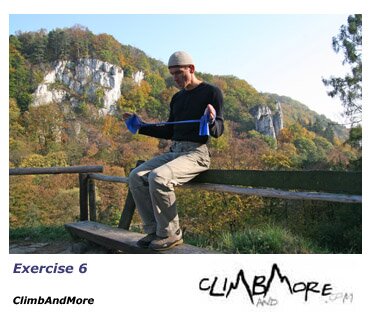Theraband - Training the Opposing Muscles
In every sport discipline training is focused on the development of strength and muscles needed for success. In extreme situations this can lead to creating big disproportions between muscle groups that we use for the given sport and the opposing muscle groups.
For climbers often seen examples of this phenomenon include arched fingers, shoulders and back. As a result many strong climber’s postures resemble those of cavemen with great tree climbing skills. Well developed and therefore shortened chest and rotator muscles pull the shoulders forward, while well developed abdomen muscles are not opposed enough by underdeveloped back muscles, which are not able to keep the back straight.
In general climbers have well developed all pulling muscles, since majority of climbing movement involves pull up type moves. Underdeveloped are generally all opposing muscles, located on the opposite side of the joint, which is often the reason for reoccurring pains in rotator or elbow joint. In order to avoid that the regular training schedule should also involve exercises of muscles not commonly used in climbing. It is good to include stretching and strength exercises for the opposing muscles. For climbers these exercises will involve mainly pushing motions. Excellent for that purpose is the use of rubber stretch band (theraband), which will provide necessary resistance.
Theraband is available in three different colours, each colour with different resistance. The blue coloured theraband will offer the potential for maximum results with minimum effort. Half a meter of theraband will be sufficient for most exercises.
Sample exercises for opposing muscles, perform 3 series, 10 reps each and one minute rest between each series:
1. Finger extensions

2. Front shoulder lifts. Arms raises to shoulder height, palms fading outward and band stretched behind back.

3. Shoulder lifts while sitting. Band stretched between arms raised to shoulder height and legs.

4. Alternating stretches with the band in front of the body, arms working diagonally.

5. Shoulder extensions from elbow joint, shoulders oriented downward stretch the band fixed above climbers head.

6. Arms bend at the elbow joint, elbows aligned with the body stretch the band moving outward.

Text by Mendoza
Pictures by ClimbAndMore
Translated by Maja Kotarska
|